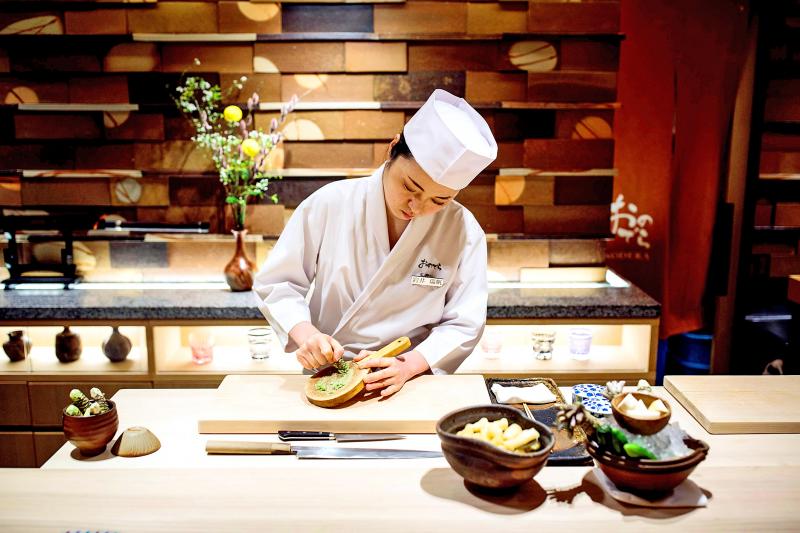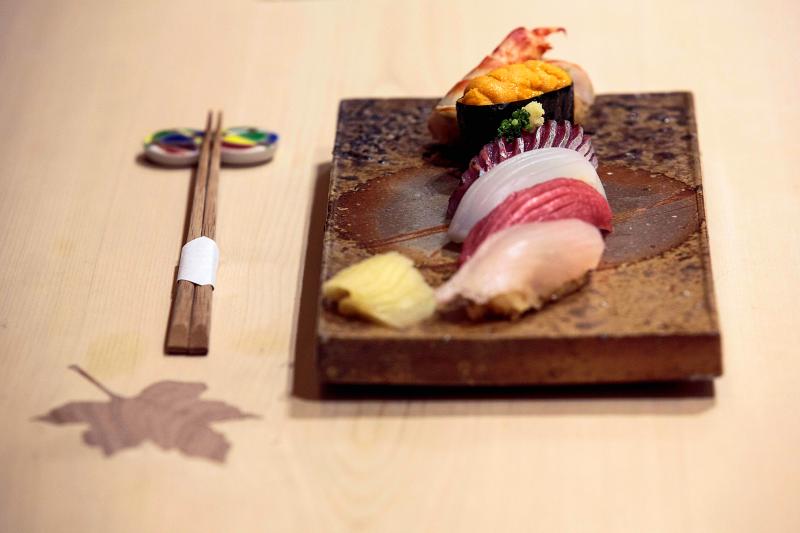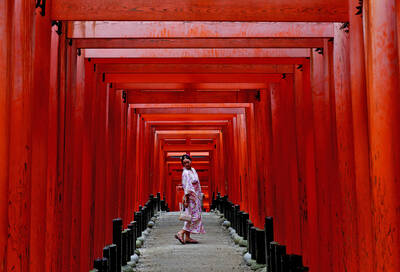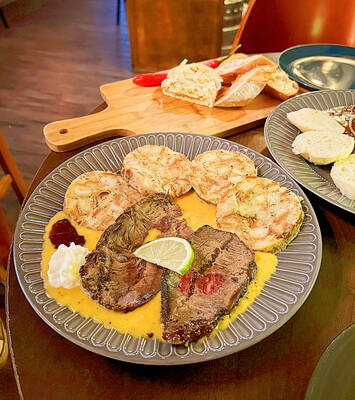Women have warm hands, their periods alter their sense of taste and they can’t work long hours — just some of the claims from those in Japan who believe women can’t be sushi chefs.
But a growing number of women in the country determined to shatter those myths are training and working as sushi chefs in some of Japan’s most revered restaurants and institutions.
Mizuho Iwai is a trainee at the upscale Onodera restaurant in Tokyo’s Ginza, a ritzy neighborhood home to some of the world’s top-ranked sushi restaurants.

Photo: AFP
In an industry where women are still rarely seen, she knew she would be an anomaly.
“I think there are a few [female] chefs but it’s rare. But I wanted to challenge things because of that,” the 33-year-old apprentice said. “I thought: this is my mission.”
And at Onodera, she’s not totally alone, there was one other woman among the 10 apprentices training at the restaurant before it recently closed temporarily over the COVID-19 outbreak. All 10 of the restaurant’s chefs are men.

Photo: AFP
The work can be grueling and requires years to master. Apprentices must learn everything from the names of different types of fish to removing scales and slicing properly. They are even instructed on how to correctly enter through the traditional drapes inside Onodera, by lifting and parting them with an elbow.
“My colleagues have accepted me,” said Iwai, who decided to become a sushi chef after cooking in small Japanese restaurants.
“They don’t treat me specially just because I’m a woman,” she added, after learning how to slice Japanese horse mackerel. “They teach me as a person.”
‘STRONG RESISTANCE’ TO WOMEN
The world of washoku, or Japanese cuisine, has long been dominated by men, more so than Italian or French cuisine, according to Fumimasa Murakami, a 54-year-old teacher at Tokyo Sushi Academy, which was still running a scaled back schedule of classes earlier this month.
There is no official data on the gender breakdown of sushi chefs in Japan, but Murakami estimates women make up “less than 10 percent.”
“[Resistance] against female chefs remains strong in Japanese cuisine, including sushi,” he said.
“Customers who don’t want a female chef at the counter do exist,” he added. “Older customers in particular have difficulty accepting it.”
But even sushi chefs have been known to repeat claims that women’s hands are too warm to keep raw fish fresh, or that their periods alter their sense of taste. Others say the job is unsuitable for women because of the long and late hours.
“In Japan, it is still strongly believed that it is women who take care of family. But sushi chefs work in the evening so it’s difficult for women,” said Yuki Noguchi, a 32-year-old former primary school teacher who finished her eight-month sushi chef training at the academy in December.
“That’s why I think the number of women who want to become a sushi chef is small in the first place,” she said.
PUNISHING TRAINING
Onodera’s head chef Akifumi Sakagami said the sushi world’s reputation for punishing training drove away women but also young people of both genders.
“I think women need a lot of courage to jump in,” the 46-year-old said.
Sakagami started as an apprentice more than 30 years ago in the northern city of Sapporo, when female chefs and trainees were essentially nonexistent.
“When I joined the industry, the working conditions in the washoku world were tough,” he said, as he showed Iwai how to thinly slice tuna and taught her how to properly peel freshly steamed shrimp. “It was long working hours with low pay. It was physically tough.”
“But the work environment is changing along with other changes in society. I think it’s getting better for both men and women,” he added.
He welcomes those changes and says being a chef depends not on gender but “competence, talent and how much effort people put in.” Fuka Sano, the other female apprentice at Onodera, said she didn’t think too much about the lack of women in the field when she decided to become a sushi chef.
“I guess women think a sushi chef is a man’s job because there are so few women,” the 18-year-old said.
But she was determined to enter the profession, after a formative trip to London.“I’m sorry to say this but sushi at chain restaurants in Britain didn’t seem appealing!” she laughed. She hopes to improve the standards of Japanese food overseas.
And Sano wants her food to be judged on its own merits, without regard for her gender.
“I want them to come (to the restaurant) for food,” she said, not “because I’m a woman.”
Her fellow apprentice Iwai hopes women like her are helping change the industry.
“It doesn’t matter whether the chef is a man or woman,” she said. “I hope the fixed image will disappear and there will be more options for women. It’s really a fun job.”

Seven hundred job applications. One interview. Marco Mascaro arrived in Taiwan last year with a PhD in engineering physics and years of experience at a European research center. He thought his Gold Card would guarantee him a foothold in Taiwan’s job market. “It’s marketed as if Taiwan really needs you,” the 33-year-old Italian says. “The reality is that companies here don’t really need us.” The Employment Gold Card was designed to fix Taiwan’s labor shortage by offering foreign professionals a combined resident visa and open work permit valid for three years. But for many, like Mascaro, the welcome mat ends at the door. A

The Western media once again enthusiastically forwarded Beijing’s talking points on Japanese Prime Minister Sanae Takaichi’s comment two weeks ago that an attack by the People’s Republic of China (PRC) on Taiwan was an existential threat to Japan and would trigger Japanese military intervention in defense of Taiwan. The predictable reach for clickbait meant that a string of teachable moments was lost, “like tears in the rain.” Again. The Economist led the way, assigning the blame to the victim. “Takaichi Sanae was bound to rile China sooner rather than later,” the magazine asserted. It then explained: “Japan’s new prime minister is

Divadlo feels like your warm neighborhood slice of home — even if you’ve only ever spent a few days in Prague, like myself. A projector is screening retro animations by Czech director Karel Zeman, the shelves are lined with books and vinyl, and the owner will sit with you to share stories over a glass of pear brandy. The food is also fantastic, not just a new cultural experience but filled with nostalgia, recipes from home and laden with soul-warming carbs, perfect as the weather turns chilly. A Prague native, Kaio Picha has been in Taipei for 13 years and

NOV. 24 to NOV. 30 It wasn’t famine, disaster or war that drove the people of Soansai to flee their homeland, but a blanket-stealing demon. At least that’s how Poan Yu-pie (潘有秘), a resident of the Indigenous settlement of Kipatauw in what is today Taipei’s Beitou District (北投), told it to Japanese anthropologist Kanori Ino in 1897. Unable to sleep out of fear, the villagers built a raft large enough to fit everyone and set sail. They drifted for days before arriving at what is now Shenao Port (深奧) on Taiwan’s north coast,